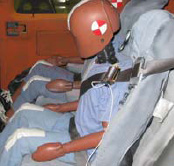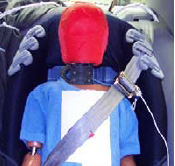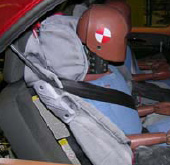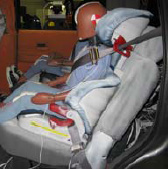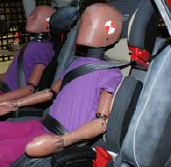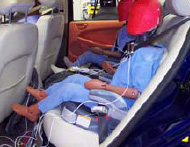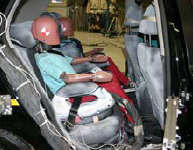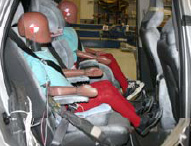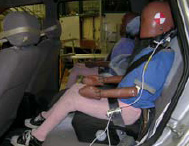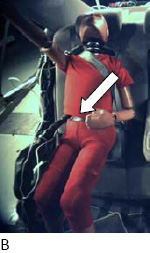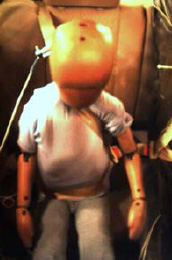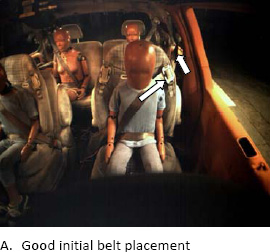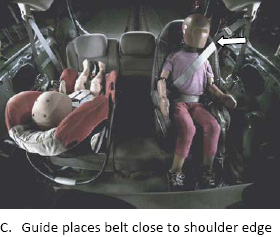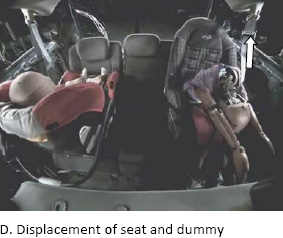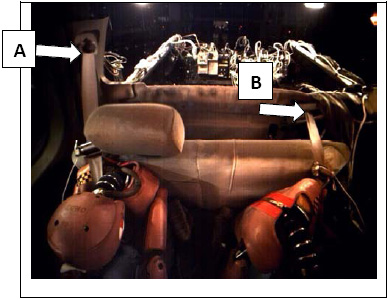INTRODUCTION
Booster seats help a vehicle's lap and shoulder belt fit school-aged children who have outgrown their forward facing child seats and who weigh at least 18 kg (40 lb). To protect a child in a crash, a booster seat should keep the lap and shoulder belt in place over his or her hips, chest and shoulder. How well a booster seat works depends on how well it fits in the vehicle and how well it fits the child.
During a frontal crash, a child will move towards the front of the vehicle. As the lap and shoulder belt holds the child back in his or her seat, it will stretch and tighten into a straight line from the child's shoulder to the point where it attaches to the vehicle. Throughout the crash, the booster seat must keep the lap and shoulder belt in place so the child can come to a controlled stop without getting hurt.
Transport Canada does testing and research on booster seats in vehicle crash tests. In testing done between 2003 and 2009, Transport Canada looked at 37 different kinds of booster seats to learn more about what is needed for a booster seat to work well and to suggest changes to regulations.
HOW RESEARCH AFFECTS REGULATIONS
Since no law in the world requires these kinds of in-vehicle crash tests to assess the safety of boosters, why does Transport Canada do them? Because vehicle seats and child seat designs change faster than standards and regulations. We look for new areas of risk and decide if current regulations need to be updated to keep children safer than ever.
We use many vehicle models (that are common on Canadian roads) with different rear seat designs, different brands of booster seats and different ways of installing them. Using child dummies of similar sizes and weight to 6 and 10 year old kids as well as a young adolescent, we crash the vehicles at different speeds, in different kinds of crashes. We also change the position of the vehicle's front seats and the size and weight of the adult dummies in the vehicle. We may even install boosters and child/infant seats next to each other, since this often occurs in real life.
DESCRIPTION OF THE BOOSTER SEATS WE TESTED
The 37 seats tested are grouped into five types.
Booster seats can have a high back or no back. We tested three types of high-back and two types of no-back booster seats (please see images of each type in Figure 1). Most were purchased from local stores and a few were obtained directly from manufacturers as samples.
HIGH-BACK BOOSTERS
A high-back booster seat has a full back, a headrest and some guides to hold the shoulder and lap belt in place.
Type 1: Has a one-piece shell; the shoulder guide is fastened to the booster seat's fabric covering. Once threaded through the clip, the shoulder belt did not slide freely and does not retract.
Type 2: Has a one-piece shell; the shoulder guides are part of the seat mould and are located on the side. In most seats, the guides were in fixed positions.
Type 3: Can be one-piece or may have a back you can take off. The shoulder guide is a plastic loop between the booster seat's headrest and back. Unlike Type 1 and 2 seats that can be converted from a forward-facing child seat by removing the harness, these are often designed to be used only as booster seats and have seat backs and/or headrests you can adjust.
NO-BACK BOOSTERS
A no-back booster seat has no back or headrest and only has guides to hold the lap belt in place.
Type 1: Has a one-piece shell, with armrests that act as guides for the lap belt.
Type 2: Is a booster cushion or shell that is rigidly attached to the vehicle with the UAS (Universal Anchorage System) or lower anchors.
| CATEGORIES of HIGH-BACK & NO-BACK BOOSTER SEATS | MAKE & MODEL | |
|---|---|---|
| TYPE 1 High-Back: Shoulder guide is fastened to the fabric of the booster seat | ||
|
||
| TYPE 2 High-Back: Shoulder guide is part of the booster seat mould | ||
|
||
| TYPE 3: Shoulder guide is a loop between the head rest and seat back | ||
|
||
| TYPE 1 No-Back: Base only uses lap and shoulder belt of vehicle | ||
|
||
| TYPE 2 No-Back: Base only, rigidly attached to vehicle with UAS | ||
|
||
RESULTS
We installed and tested 231 booster seats in 144 motor vehicles. Most of the tests were done in vehicles during frontal crash rigid wall compliance tests (to assess the protection of front seat occupants) at 48 km/h, a severe crash. Others were done in vehicles during rigid barrier tests at 40 km/h, a moderately severe crash. The rest of the vehicle tests, including those done in the rear seat of a car that crashes into the side of a parked car, were less severe crashes.
Some dummies were seated in an erect posture and in contact with the seat back. Others were slouched with their bottoms not in full contact with the seat back (the booster seat back or the vehicle seat back, depending on whether the booster seat had a back). Although this may not follow a manufacturer's instructions, it represents how real children might sit.
NOTE: Transport Canada does not do these tests to rate, rank, or endorse individual booster seats. However, we did learn how various booster seats perform in frontal crashes and what types of designs performed better than others. At the present time in Canada, booster seats are not required to meet dynamic test requirements, where their performance is evaluated in simulated crashes on a sled apparatus.
The videos were analyzed and grouped into four categories:
- The good category shows tests where the shoulder belt stayed in place on the dummy's shoulder, and the lap belt stayed on the hips during the entire crash.
- The roll-out category shows tests where the shoulder belt slipped off the shoulder or the dummy rolled out of the shoulder belt (Figure 2A). The lap belt stayed on the hips during the entire crash.
- The abdominal load category shows tests where the lap belt rode up into the abdomen (stomach). The dummy on the left of Figure 2B shows you what this looks like.
FIGURE 2: EXAMPLE OF ROLL OUT (A) AND ABDOMINAL LOADING (B) - The neck category shows tests where the shoulder belt slipped from the shoulder and onto the neck and the underarm of the dummy. For example in Figure 3, the shoulder belt is attached behind the right shoulder of the dummy, and the belt crosses over the neck and under his left arm.
FIGURE 3: FRONT AND SIDE VIEW OF A SHOULDER BELT CROSSING THE NECK AND UNDER THE ARM.
High-back booster seats with shoulder belt guides that were either sewn to their fabric covering or were part of the plastic shell (high-back Type 1 and 2) were the least effective at keeping the shoulder belt in place during the crash. In fact, the roll-out rate for the Type 1 high-back booster seats was 32 per cent, which was higher than for either type of no-back booster seats. The belt guides on these high-back booster seats can give you a false sense of security because before anything starts to move, the belt position over the shoulder looks fine.
Figures 4A through 4D show two seat types before and during the crash. Photo A is a Type 1 booster seat with the guides stitched to its fabric covering. There is good belt fit to start. The arrows follow the jagged path of the belt to its attachment point behind the dummy. During the crash, as the dummy and booster seat move forward, the belt stretches and straightens out along the arrow in photo B. The shoulder belt slides off the shoulder and allows the dummy to roll out of the belt.
FIGURE 4: EXAMPLES OF DIFFERENT SHOULDER BELT GUIDES; THE BELT FIT BEFORE AND DURING A CRASH
In photo C, the belt guides are brackets on either side of a Type 2 high-back booster seat. In this case, the guide is too low, so the shoulder belt starts out near the edge of the shoulder. During the crash, the belt pops out of the guide and follows the path of the arrow shown in photo D, and the dummy rolls out of his shoulder belt.
In moderate to severe crashes, 65 per cent of the Type 3 high-back booster seats we tested gave good protection during a crash. The closeness of the guide to the shoulder helped the shoulder belt stay in place.
In Figure 5, both dummies were seated in the same Type 1 no-back booster seat model, but the attachment points for the two seat belts were different. A is higher than B. During the crash, the dummy on the left was held back by the shoulder belt and well protected. The dummy on the right rolled out of his belt, and was not as well protected.
FIGURE 5: SAME BOOSTER SEAT, SAME DUMMY BUT DIFFERENT SEAT BELT GEOMETRY LEADS TO DIFFERENT RESULTS.
The Type 2 no-back booster seats attached to the vehicle with the lower anchors or UAS, worked well in mild crashes, but increased the risk of the belt injuring the child's abdomen and under the arm in moderate to severe crashes, especially when the child is sitting in a slouched posture. Why?
- The booster seat's rigid attachment does not allow it to move forward. The bigger and heavier a child is, the more likely the front edge of the booster cushion will tip down as he or she slides forward. This increases the likelihood that the lap belt will ride over the abdomen. And since children don't always sit according to manufacturer's instructions, sudden braking or swerving before a crash can place a child further forward on the booster seat. This reduces the distance between the child's bottom and the front edge of the booster seat, which means a child can drop off the front edge of the booster cushion if the collision is severe.
- In one model, the vehicle lap and shoulder belt is routed through two plastic guides on either side of the cushion (Figure 6). As the child moves forward with the belt around his or her hips, the belt stretches forward with the child and can slide out of these guides. This releases the extra length of webbing that was routed through the guide, and can cause the child to move even further forward towards the edge of the seat. This increases the risk of the lap belt injuring the child.
FIGURE 6: LAP AND SHOULDER BELT ROUTING IN TYPE 2 BOOSTER SEAT.
ADDITIONAL INVESTIGATION
Exploratory testing was conducted beyond the scope of the research program described above, using an acceleration sled and U.S. regulatory testing conditions. During this testing, the dummies were seated erect and held in place using the lap and shoulder belt and the seat was attached to the vehicle using the UAS. The Type 2 no-back booster seat showed no evidence of the lap belt riding up over the abdomen . However, the shoulder belt was observed to slip off the dummy's shoulder during some tests. Transport Canada has not received any reports of in-use problem issues with these booster seats nor have we received reports from the public suggesting that the seats are defective or have caused injuries. U.S. Government authorities have indicated that they have not observed any noncompliance issues with similar U.S. market seats, are not aware of in-use concerns with the seats, nor received any allegations of defects from the public. It should be noted that the Type 2 no-back booster seats tested by Transport Canada may also be installed without the UAS attachment method, according to the manufacturer. Hence, acceleration sled testing was also conducted without attaching the seat to the vehicle using the UAS and the dummy was held in place by the lap and shoulder belt. Again, there was no incidence of the lap belt riding up over the abdomen. However, shoulder belt slippage did occur. In-vehicle testing without this rigid attachment will be conducted in the future.
CONCLUSIONS
This study looked at many different kinds of booster seats sold in Canada since 2003, to learn more about what is needed for a booster seat to work well and what to require in future regulations. We learned that:
- To work well and provide good protection, a booster seat must be able to keep the lap and shoulder belt in place throughout a crash. This depends on the:
- path of the vehicle lap and shoulder belt, and how well the booster seat can re-direct it so that it stays in place during a crash; and the
- height and weight of the child or how well the booster seat fits the child.
- Most booster seats did a good job of keeping the lap belt from riding up into the abdomen but many could not keep the shoulder belt on the shoulder throughout the crash.
- The Type 3 high-back booster seats with the shoulder belt guide located close to the shoulder provided the best protection overall. Type 1 and 2 booster seats that relied on guides that were stitched to the cloth or that formed part of the seat back were not as good at keeping the shoulder belt in place. Many didn't have a way to correctly fit the shoulder belt on the child.
- The Type 2 no-back booster seats attached with lower anchors were the only booster seats we found to increase the risk of having the lap belt ride up into the abdomen and/or the shoulder belt ride up under the arm. The Type 1 no-back booster seats performed as well as many high-back booster seats.
RECOMMENDATIONS FOR FUTURE REGULATIONS
Dynamic testing should be required in Canada and take into consideration:
- A test seat with a cushion stiffness that is stiffer and more representative of the cushions found in vehicles today;
- A crash severity that approximates the energy that is generated during a full frontal rigid barrier crash tests performed for the regulatory monitoring of adult protection in the front seats of vehicles;
- Future regulations should consider visually tracking the lap and shoulder belt placement throughout crash testing for a range of seat belt anchor points and dummy sizes. This would help us monitor how well the booster seat can re-position the lap and shoulder belt and protect the child during a severe crash.
REGULATORY UPDATE:
On August 15, 2009 Transport Canada published a Notice of Intent to amend its child seat regulations. This Notice proposed adding dynamic testing requirements similar to those used in the U.S. and which conduct the testing using an acceleration sled.
HOW TO FIND A BOOSTER SEAT THAT FITS
A booster seat must fit both the child and the vehicle you plan to use it in.
Before buying a new booster seat or using a forward facing child seat that has been converted to a booster seat:
- Place the booster seat in the rear seat of the vehicle where you expect to use it;
- Have the child seat him/herself and fasten the seatbelt, respecting any belt guides that may be present on the seat. If the booster seat is equipped with an adjustable head rest, adjust it so that the child's ears are vertically centered with the head rest;
- Look at the lap and shoulder belt:
- If the lap belt fits low over the hips, and the shoulder belt is centered with the shoulder, go to step 4.
- If you see any of the following happening, choose another seat and start again at Step 1:
- If the lap belt rides high on the hips; or
- The shoulder belt is off the shoulder; or
- The shoulder belt is crossing over the neck.
- Pull out about 15 cm (6") of the lap and shoulder belt to get some looseness, and hold it to prevent it from sliding back into the retractor. Ask the child to raise both arms out in front at shoulder level, lean forward and wiggle his or her bottom forward until there is no looseness left in the belt.
Release the belt and ask the child to stay like this, long enough for you to look at how the belt has moved. This is more or less how much your child could move during a serious frontal crash. - Look at the lap and shoulder belt:
- If the shoulder belt is still on the shoulder and the lap belt has stayed in place over the hips, this booster seat FITS the child and the car.
- If you see any of the following happening, choose another seat and start again at Step 1:
- The lap belt has moved above the hips and onto the belly, or
- The shoulder belt has slipped off the shoulder; or
- The shoulder belt is pressing on the neck.
APPENDIX A: RESULTS FOR THE 6-YEAR-OLD DUMMY IN 35 TO 56 KM/H CRASHES BY MAKE AND MODEL OF BOOSTER SEAT
| Make | Model | n | ROLLOUT | LAP / ABDOMEN | NECK | GOOD / NECK | GOOD | GOOD / REBOUND |
|---|---|---|---|---|---|---|---|---|
| Britax | Bodyguard | 2 | 1 | 1 | ||||
| Britax | Monarch | 1 | 1 | |||||
| Century | Breverra Contour | 5 | 5 | |||||
| Century | Next step | 3 | 1 | 2 | ||||
| Clek | Olli | 1 | 1 | |||||
| Clek | Oto | 17 | 3 | 10 | 3 | 1 | ||
| Compass | B505C | 2 | 2 | |||||
| Cosco | Alpha Omega Elite Dlx 3-IN-1 | 5 | 5 | 1 missing view | ||||
| Cosco | Complete Voyager | 2 | 2 | |||||
| Cosco | Explorer SHIELD | 1 | 1 | |||||
| Cosco | Highrise | 13 | 4 | 1 | 7 | 1 | ||
| Cosco | Traveller | 2 | 1 | 1 | ||||
| Cosco | Ventura | 1 | 1 | |||||
| Eddie Bauer | Alpha Omega Elite Dlx 3-IN-1/DLX | 2 | 1 | 1 | ||||
| Eddie Bauer | Auto Booster | 1 | 1 | |||||
| Eddie Bauer | High-back | 2 | 2 | |||||
| Evenflo | Big Kid Deluxe HB | 2 | 2 | |||||
| Evenflo | Confidence | 4 | 4 | |||||
| Evenflo | Express | 10 | 3 | 1 | 2 | 2 | 2 | |
| Evenflo | Traditions | 3 | 1 | 2 | ||||
| Evenflo | Vision | 9 | 1 | 4 | 4 | |||
| Graco | Airbooster | 4 | 3 | 1 | ||||
| Graco | Cargo | 8 | 2 | 1 | 5 | |||
| Graco | Nautilus | 6 | 6 | |||||
| Graco | Platinum Cargo | 7 | 2 | 2 | 3 | |||
| Graco | Treasured Cargo | 8 | 1 | 3 | 4 | |||
| Graco | Turbo booster | 34 | ||||||
| High Back | 15 | 5 | 0 | 2 | 7 | 1 | ||
| Low Back | 19 | 5 | 2 | 4 | 6 | 2 | ||
| Safety 1st | Apex | 1 | 1 | |||||
| Safety 1st | High back | 5 | 1 | 3 | 1 | |||
| Safety 1st | Intera 4 in 1 | 4 | ||||||
| High Back | 2 | 2 | ||||||
| Low Back | 2 | 1 | 1 | |||||
| Volkswagen | Integrated | 4 | 4 |
Key: n represents the total number of times that a booster seat was tested. The various numbers under the individual headings add up to n.
APPENDIX B: SUMMARY OF TEST SPEEDS AND RESULTS BY TYPE OF BOOSTER SEAT
| < 35 km/h | 40 km/h | 48 km/h | 50 km/h | 56-57 km/h | 60-64 km/h | TOTAL | |
|---|---|---|---|---|---|---|---|
| Rigid Barrier | 13 | 51 | 92 | 27 | 183 | ||
| Offset Barrier | 1 | 13 | 11 | 25 | |||
| Vehicle-to-Vehicle | 23 | 23 |
| Seat Type | Roll-out | Abdominal | Neck | Good / Neck | Good / Rebound | Good |
|---|---|---|---|---|---|---|
| Type 1 HB
n=36 |
10 | 0 | 1 | 6(4) | 0 | 14(1) |
| Type 2 HB
n=52 |
10(3) | 4 | 2 | 4(2) | 6 | 15(4)[2] |
| Type 3 HB
n=59 |
5(1) | 3 | 1 | 2 | 3 | 32(4)[8] |
| Type 1 NB
n=47 |
9(1) | 0 | 3 | 5(3) | 3 | 21[2] |
| Type 2 NB
n=31 |
3(2)[1] | 11 | 3 | 0 | 1[2] | [8] |
| (# of offset deformable barrier tests) [# of crashes into the side of another] | ||||||
| Seat Type | Roll-out | Abdominal | Neck | Good / Neck | Good / Rebound | Good |
|---|---|---|---|---|---|---|
| Type 1 HB
n=31 |
32%
n=10 |
0 | 3%
n=1 |
19%
n=6 |
0 | 45%
n=14 |
| Type 2 HB
n=37 |
24%
n=10 |
10%
n=4 |
5%
n=2 |
10%
n=4 |
15%
n=6 |
37%
n=15 |
| Type 3 HB
n=40 |
13%
n=5 |
8%
n=3 |
3%
n=1 |
5%
n=2 |
8%
n=3 |
65%
n=26 |
| Type 1 NB
n=35 |
25%
n=9* |
0 | 8%
n=3 |
14%
n=5 |
8%
n=3 |
42%
n=15 |
| Type 2 NB
n=18 |
17%
n=3 |
61%
n=11 |
17%
n=3 |
0 | 11%
n=1 |
0 |
NOTICE: This document is based in part, on an internal research report prepared within Transport Canada on the results of booster seat testing conducted during 2003-2009, as well as other internal sources of information.
